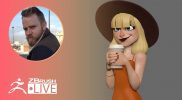

I guess I don't have much to say about the accessories. When I was done I started to model the accessories in Softimage (Fig.06). Observe some patterns that cloth makes when it folds on itself and how it behaves when near a point of tension (like near the armpits when the arms are down). Try to understand how cloth reacts to gravity and how it folds on top of itself. When sculpting clothes it's really important to take into consideration some elements like gravity and points of tension. That way I naturally go from big forms to smaller forms and then details. I always sculpt as much as I can on the subdivision that I'm on at the moment before subdividing it again. I grabbed all the references that I had of pants and jackets, and sculpted the folds and later the details (Fig.05). Then I went into ZBrush and started to sculpt the pants and the jacket. That helps a lot when the sculpting part comes because your mesh will subdivide better and you'll avoid some problems. Since the base mesh was going to be used to sculpt in ZBrush I made sure that I had an all quad base mesh with even spaced edges. The brushes that I mainly used were: Clay, ClayBuildup, Standard, Smooth and Move (Fig.02 - 03).Īfter I finished the body and head, I started to model the base meshes of the clothes and accessories in Softimage (Fig.04).

ZBrush was used for all my sculpting on this character. I have a folder with tons of anatomy images so that was my main source of references, but I'm always looking on Google and in books for more because you can never have too many anatomy images to help you with your sculpting. When modeling characters I always look for as many anatomy references as possible. I think it was a great opportunity to practice and study anatomy. Although the majority part of his body wasn't going to be visible, I sculpted everything except for the feet.

So I gave more attention to the head to make it look the way I wanted it to. I made a very simple base mesh using ZSpheres inside ZBrush and then I started by sculpting the head because it's usually the most expressive part of a character. If your model doesn't look right at this stage it won't look right with clothes and everything else. So you have to pay a lot of attention when doing this to make sure your character has good and correct proportions. This is a very important part because it's at this stage that you will give the proportions to the character. I started the high poly model by sculpting the body and the head. I didn't need to look for reference for some of his accessories as I own things like the watch, bracelet, dog tag and sunglasses, so in that way I was able to put some part of me into the character. I also started to look for references of the accessories (gun, badge, handcuffs and so on). So I just went on Google and searched for as many references as I could find of jeans,, shirts and leather jackets (Fig.01). The clothing was going to include all of those studies that I wanted to do. I knew that I didn't want to make him look generic so I had in my mind the basic idea of giving some kind of different hair style and bear. With the idea of making a cop in mind, I started searching for references. That's when I came up with the idea of making a cop character. And since I'm a huge fan of real-time characters, I started to think about what kind of character I could do that may have all of those characteristics. I also have been flirting for some time with the idea of doing a nice jacket so I could practice sculpting some cloth folds and doing a nice leather texture. For example, I wanted to make some studies of cloth folds, but didn't want to make just a shirt or a pants sculpture. Red Beard Cop was a personal project that started as mix of the many studies that I wanted to do. My name is Leandro Pavanelli and I'm a freelance 3D modeler from Brazil.


 0 kommentar(er)
0 kommentar(er)
